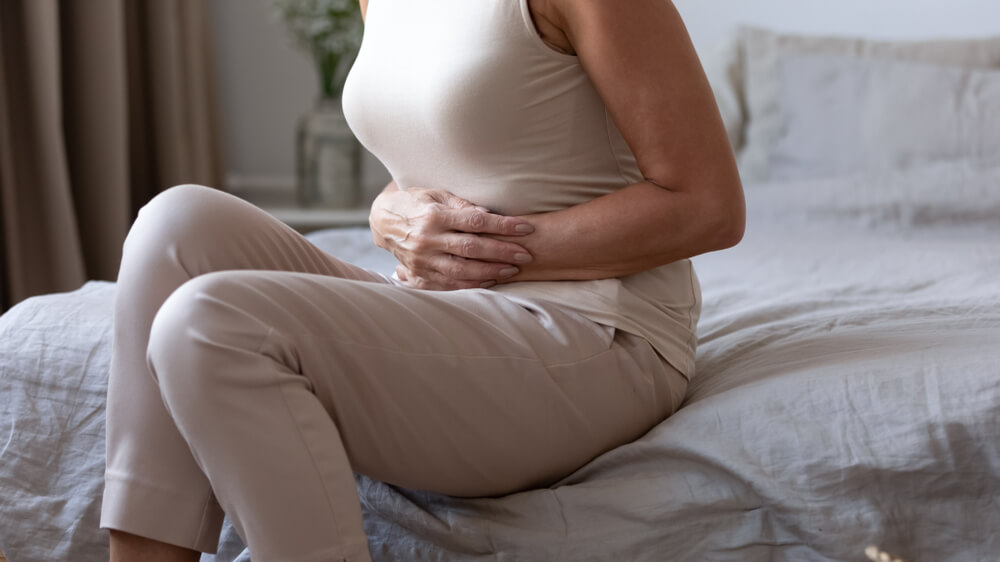What is Menopause?
Menopause is the stage in a woman’s life when reproductive hormones drop and monthly menstrual periods end for over a year. During menopause, women begin to experience various symptoms, including hot flashes, mood changes, sleep problems, slow metabolism, and more.
During postmenopause, many of these symptoms subside, but this period can lead to different symptoms. Women may experience vaginal dryness, stress incontinence, chronic urinary tract infections, decreased libido, weight gain, insomnia, and postmenopausal vaginal bleeding.

What Causes Post-Menopausal Bleeding?
After menopause, you should not be experiencing menstrual bleeding. The primary four causes of postmenopausal bleeding include uterine polyps, endometrial hyperplasia, endometrial atrophy, and cancer. However, these four causes of postmenopausal bleeding are not the only related conditions. Bleeding vaginally after menopause is not normal, and even if it is simply spotting, we recommend speaking to your doctor to rule out serious health issues and determine what causes post-menopausal bleeding for you.
Here are some causes of postmenopausal bleeding:
- Pelvic Trauma – Trauma or injury to the pelvis may cause bleeding.
- Uterine polyps or fibroids – Growths known as polyps appear in your cervical or uterine canal or on the cervix itself. They are usually benign but may cause heavy bleeding or spotting or bleeding after intercourse.
- Endometrial atrophy – The endometrium is the tissue lining your uterus, and endometrial atrophy is the thinning of the uterine lining. Because the endometrium responds to hormones such as estrogen and progesterone, menopause or the decline in hormones can make the endometrium much thinner and triggers bleeding.
- Endometritis – An infection of the uterine lining.
- Bleeding – Bleeding may occur from the urinary tract or rectum.
- Cancer – One of the most common symptoms of cancer of the vagina, uterus, endometrium, and cervix is irregular bleeding after menopause.
- Vaginal Atrophy – Low estrogen levels after menopause can make the vaginal walls thinner, inflamed, and dry. These effects can lead to vaginal bleeding, especially after sex.
- Endometrial Hyperplasia – A shift in hormones after menopause, meaning too much estrogen and too little progesterone, can make the endometrium thicker and cause it to bleed. Abnormal cells in the endometrium can occur and lead to cancer, so it is best treated early.
- Sexually Transmitted Diseases – STIs and STDs such as chlamydia and gonorrhea, or sores from herpes, can cause spotting or bleeding after sex. Regular STI and STD testing is recommended to stay informed and reduce risks of complications.
- Medication – Certain drugs, such as hormone therapy, blood thinners, and more, can trigger side effects, including postmenopausal bleeding.
Even though the root of your postmenopausal bleeding may be harmless, it is crucial to contact and visit your doctor right away because it can point to more severe conditions.
Is Bleeding Normal During Perimenopause?
Perimenopause, or the years leading up to menopause, is a period of time in which your hormones shift and your menstruation may change. Spotting and a heavier or lighter period are normal. If your bleeding is lasting longer than usual or is especially heavy, or if you are bleeding more often after intercourse, consult your doctor. Even if irregular bleeding only occurs once, is a small amount, and you do not have other symptoms, we recommend taking the precaution regardless. Many causes of postmenopausal bleeding are typically not serious, but if they were to be, cancers are most easily treated when they are detected early.
How Is Postmenopausal Bleeding Diagnosed?
If you have reached out to your physician about determining what causes of postmenopausal bleeding you have been experiencing, the next step will be a visit to the doctor to review medical history, have a physical exam, and have necessary tests to determine the cause or rule out serious conditions.
Here are some tests used to diagnose postmenopausal bleeding:
Physical Exam – Before deciding the next steps in diagnosing your postmenopausal bleeding, your doctor will begin with a routine physical and pelvic exam to check for any abnormalities or tenderness and may even conduct a pap smear test.
Transvaginal Ultrasound – During this procedure, an imaging technician or your doctor will insert an ultrasound transducer, or wand, into the vagina to view the ovaries, uterus, and cervix.
Endometrial Biopsy – A thin tube is used to take a small sample of the tissue lining your uterus. This sample will be sent to a lab to rule out things like infections or cancers.
Sonohysterography – Your doctor will put a saltwater solution inside your uterus to create a clear ultrasound image and measure a polyp.
Hysteroscopy – This is a thin, lit tube with a camera to help your doctor look inside your uterus.
D&C – Or dilation and curettage is a procedure in which your doctor opens the cervix. A thin tool is used to collect a sample of the uterine lining, which is then sent for screening of cancer, polyps, and endometrial hyperplasia. Hysteroscopy and D&C require anesthesia, so you will have to have these procedures in a hospital or outpatient surgery center.
How Is Postmenopausal Bleeding Treated?

Depending on what causes post-menopausal bleeding, your doctor can help determine what treatment or therapy is right for you.
Medication – Antibiotics can be used for cervical or uterine infections, STDs, and STIs. They are prescribed to clear up symptoms, including irregular bleeding.
Estrogen therapy – Estrogen is used to help vaginal and endometrial atrophy, and it can be prescribed in various forms. These include oral pills, vaginal cream, the vaginal ring, or vaginal tablets.
Progestin therapy – Progesterone is used to help ease endometrial hyperplasia. Progesterone comes in various forms as well, including a pill or shot, a vaginal cream, or an intrauterine device.
Surgery – Surgeries include D&C, or dilation, and curettage, and hysteroscopy is performed to remove polyps and thickened parts of the uterine lining from endometrial hyperplasia.
Hysterectomy – This is a major surgery that doctors use as a treatment for endometrial or cervical cancer. During the procedure, part or all of the uterus will be removed, and in some cases, your doctor will need to remove your ovaries, fallopian tubes, or affected lymph nodes as well.
Systemic Therapy – Chemotherapy, radiation, and hormone therapy are used in cancer treatment after surgery. The kind of systemic therapy you receive will be dependent on the kind of cancer you are experiencing and what stage it is in.
Prevention of abnormal postmenopausal bleeding is key, and the most effective way to do this is by reducing your risk factors for the conditions that can cause it. For example, treating endometrial atrophy early can prevent it from progressing into cancer. Another example is screening for conditions early, before postmenopausal bleeding may even begin. Overall, we recommend maintaining a healthy diet and engaging in regular exercise, as well as maintaining a healthy weight, is crucial in preventing various conditions and complications in the body.
How Can My Doctor Help?
Our team at Trogolo Obstetrics and gynecology are highly skilled, trained, and compassionate professionals who are here to guide you on your postmenopausal journey. Remember, early detection and treatment are crucial in resolving serious conditions, especially cancer. We recommend that women visit their gynecologist and primary care doctor every year to receive proper examinations and necessary screenings. Visit our website or give us a call today to schedule your well-visit and make sure your health is on the right track!


